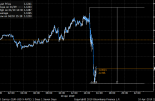La Française: Inflation and strategic asset allocation

Beyond the fluctuations in economic growth that guide tactical asset allocation, the most fundamental question for strategic allocation is the inflation regime that the developed world stands to experience in the coming years.
It all started with the ultra-accommodating monetary policies put in place in 2009 in the United States and in 2015 in the eurozone to counter the effects of the global financial crisis, with the corollary of money supply growth of more than 20% at an annual rate over a long period. The fuel was in place. The onset of Covid then ignited inflation with a constraint impact on supply linked to containment and an overstimulation impact on demand linked to public support measures.
Against this backdrop, headline consumer price inflation in the US and Europe now stands at nearly 8% and 10% respectively year-on-year and shows few signs of abating anytime soon. Inflationary pressures are likely to ease from 2023, but at what pace and at what level will they eventually settle down? Responsible financial management can no longer put off thinking about what the principles of strategic asset allocation might be under a regime of higher inflation than has been experienced by the vast majority of managers currently in charge.
Asset allocation under different inflation regimes
There is a broad consensus in academic research that a level of inflation between 0 and 3% is considered normal, above 3% and up to 10% as a high level of inflation and above 10% as hyperinflation regime, implying that inflation is getting out of control. There is also agreement that financial and real estate markets behave differently in periods of normal inflation than in periods of high inflation.
In times of normal inflation, the main factor influencing the markets is economic growth. The equity market becomes a driver, as growth is its main indexing factor. The correlation between equities and bonds is therefore fairly negative. This has been observed throughout the rise of globalisation, with growth essentially dependent on demand without supply constraints.
In times of high inflation, the main factor influencing the markets is inflation. The bond market becomes a driver, as interest rates respond primarily to inflationary expectations. The correlation between equities and bonds is therefore fairly positive. This is what we are likely to see as globalisation recedes and growth becomes essentially dependent on the availability of supply.
Real estate rarely drives the markets, and when it does, it is during a major financial crisis. This asset is mainly sensitive to real interest rates. A rise in interest rates above inflation is conducive to a fall in real estate, in which case the correlation between real estate and bonds is positive. If, on the other hand, the rise in interest rates is lower than inflation, real estate holds its own and the correlation is negative. This is what generally happens, because interest rates react with a delay and in a reduced manner in the face of inflation.
In summary, what distinguishes asset allocation in times of high inflation from allocation in times of normal inflation is not only the focus on real rather than nominal performance, but also the construction of a portfolio that favours a balance between securities and real estate rather than between equities and bonds.
What Type of Asset Allocation for a Medium/Long Term Investment Horizon?
Beyond the negative real growth impact that our economies are currently experiencing, how can we apply this paradigm shift to our asset allocations for professional investors with an investment horizon of more than 5 years?
The context of climate transition, coupled with the gradual decline in fossil fuel reserves, is set to lead to a trend towards higher energy prices in the coming years. In terms of asset allocation, this should translate into greater exposure than before to commodities and to sectors whose profits are positively correlated to these assets. This applies to both equities and bond assets. Conversely, business models that depend on stable, low-cost energy supplies may have more difficulty.
We are potentially heading for a very uncertain period in which inflation and disinflation, growth and recession could follow on from each other. These periods are conducive to strong differentiation between the various segments of the economy. Long-term trends such as the growth of cities, decarbonisation and digital innovation will lead to the emergence of the major players of tomorrow, as has been the case over the last 20 years with the development of the internet. In our view, these trends should form the basis of long-term asset allocation today, and again, regardless of the assets under consideration.
The massive investments needed to meet the challenges ahead will also require very strong support from States, which will see their need for financing increase. The current restrictive financial conditions will probably need to be relaxed in the medium term to allow for such financing. This should be accompanied by lower real interest rates (but not as low as in the last 10 years) and higher break-even inflation rates than at present. On this last point, it is striking to note that today the financial markets are expecting inflation to return to the central banks' targets around 2% very quickly, which has not been the case historically.
Government bonds are structurally underweighted. Beyond the trend in inflation, which should have a lasting negative impact on this asset class, it is likely that government actions will hit the bond market. The example of the UK illustrates this point and shows that it will be difficult for central banks to maintain restrictive monetary policies for prolonged periods of time.
To put it more bluntly, a period of high nominal growth should help corporate earnings to remain resilient even if large sectoral disparities arise. However, this positive factor will be offset by likely increases in business taxation. The overall path could therefore ultimately be rather chaotic but not necessarily negative, at least in nominal terms.
There are likely to be many disparities within corporate bonds as well. Some companies that owe their existence exclusively to extremely low financing rates will find it difficult to survive. A rise in default rates is therefore likely in the medium term, hence our preference for good quality bonds, rated BB or better, bearing in mind that these assets are quite sensitive to interest rate risk.
Real estate, on the other hand, offers an interesting protection in times of inflation as its income is indexed to inflation. This inflation cover may have been provided for in leases. This is particularly the case in France where leases are indexed to indices directly linked to inflation. This is also the case in Spain and the Netherlands. This is less commonly seen in Germany and rarely the case in the UK, with the exception of supermarkets.
However, inflation protection may be limited if there is a cap on the indexation indices. These caps are intended to preserve the purchasing power of the occupants of real estate assets. They are generally found in residential assets and some commercial assets. Similarly, several significant increases in indexation indices could erode the solvency of tenants. Preference should be given to users with significant pricing power, i.e., who are able to pass on the inflated expenses to their sales prices.
In times of inflation, it is therefore essential to have a cross-analysis by asset type and by sector of activity to identify the assets offering the best protection against inflation. We favour offices leased to growth sectors (luxury, energy, transport, etc.), healthcare assets or managed residential properties with little impact from economic cycles and retail brands in growth sectors.
Rising inflation may result in higher capitalisation rates and higher financing rates. In order to limit the negative impacts of this increase, it is advisable to favour scarce assets, i.e., those in markets characterised by low vacancy. The low vacancy rate comes as a result of land scarcity in urban areas and regulations that limit the production of new supply to meet the objectives of a strong reduction in new land use. We favour dense urban areas where the building can be converted to another use if necessary. Vineyard products whose land value is based on being part of a limited terroir and whose prices are expected to follow inflation may also present an interesting solution.









